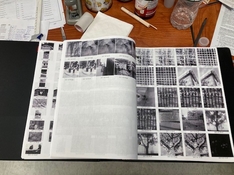I scan all my negs for years so I have them all in Lightroom. Of course, if I'm being critical, maybe 10% is worth printing. If I'm being very critical, that ratio is even lower. But there are many family snapshots, kids, travel, street photos, that are not masterpieces by any means, but would be cool to have them printed. What I end up printing is some abstract work, that I love, but maybe nobody else would care about it

My point is: I'll probably not ever print most of these negs in silver just because it's time consuming and expensive, even though I'd like to have them all printed, it's not worth. I’ve printed a lot of inkjets on the highest quality archival paper, calibrated everything to perfection, but they just don’t resonate with me. To me, inkjets are more like physical alternatives to screens—they don’t feel the same as my silver or platinum prints. But that’s okay, we’re not living in an ideal world.








